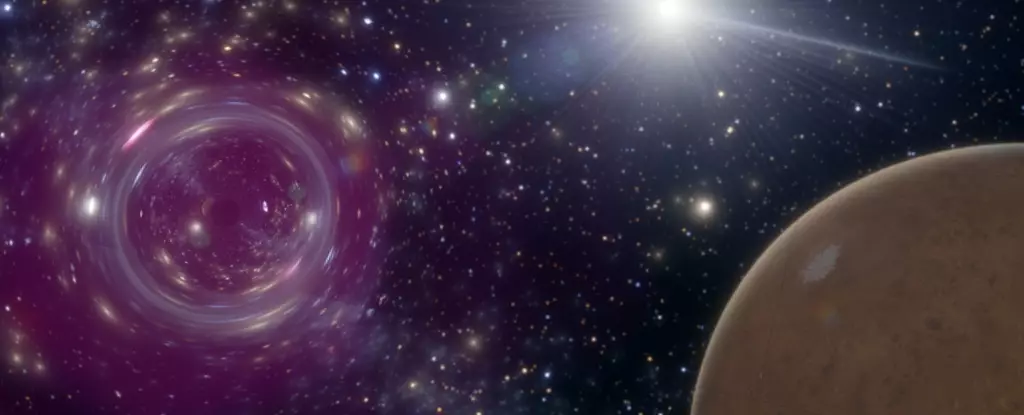The universe is a realm of enigmas, where black holes stand as some of the most perplexing entities. Among them, primordial black holes (PBHs) are particularly fascinating, as they are theorized to have emerged within moments of the Big Bang—distortions in spacetime birthed from exceedingly dense regions of matter. Recent research led by a team of physicists at the Massachusetts Institute of Technology (MIT) has sparked intriguing possibilities regarding the presence and movements of PBHs within our Solar System. By focusing on Mars and its orbital dynamics, the research aims to uncover more about these elusive objects and, potentially, the nature of dark matter.
Dark matter is a principal component of our universe, yet it remains largely an abstraction. Unlike ordinary matter, which emits and interacts with light, dark matter does not exhibit detectable electromagnetic radiation. Instead, its existence is inferred from gravitational effects on visible matter and cosmic structures. Primordial black holes have emerged as a compelling candidate for dark matter, as they might account for the gravitational pull without revealing themselves through traditional observational means.
The recent study suggests that these PBHs could pass close to Earth at an astonishing frequency—approximately once every decade. While they remain invisible to direct observation, their gravitational influences could result in measurable disturbances, particularly on the red planet, Mars. The calculations indicate that if a PBH approached Mars within a distance of around 450 million kilometers (about 280 million miles), it could cause a slight but detectable change in the planet’s orbit—specifically, a wobble amounting to about 1 meter (3.3 feet) over a decade.
The fascinating aspect of this research is the meticulous method employed to estimate the influence of a PBH on Mars. The team began with a whimsical hypothetical scenario: what if a PBH somehow zoomed past an individual? This thought experiment transitioned into more serious considerations regarding the motion of celestial bodies. Lead author Tung Tran emphasized that even a PBH with a mass equivalent to that of an asteroid could evoke significant changes in planetary behavior.
The study involved simulating various scenarios where a PBH might interact with not only Mars but also Earth’s Moon and other nearby celestial entities. Despite investigating the wobble potential of several planets, Mars emerged as the most promising candidate due to its intense monitoring and study by scientists. The clarity of the Martian wobble as a potential indicator of a PBH flyby could represent a rare opportunity to harness observational tactics to explore phenomena beyond direct visibility.
One might wonder whether the presence of ordinary asteroids—frequent visitors to our solar neighborhood—could produce similar effects. In principle, asteroids do exert gravitational influences; however, the context in which they operate is starkly different. Most asteroids navigate predictable orbits in a well-defined structure around the Sun, leading to interactions that play out over extended timeframes. In contrast, a PBH travels at immense velocities, often exceeding 200 kilometers per second, allowing for instantaneous and sharp impacts on celestial dynamics.
This speed factor is crucial. While asteroids contribute to a steady background of interactions, a passing PBH could stand out as a clear anomaly due to its rapid motion. Researchers acknowledge this distinction but also emphasize the necessity of conducting more comprehensive simulations to further decipher the overall gravitational landscape of our Solar System when influenced by both asteroids and PBHs.
As scientists continue to map the cosmos and its secrets, the prospect of encountering primordial black holes ignites a new layer of excitement in astronomical exploration. The findings from MIT’s research pave the way for potential future discoveries that could intersect with understanding dark matter—a critical component in the fabric of the universe. The alignment of technology and theoretical astrophysics hints at the possibility that, sooner or later, researchers may indeed witness measurable manifestations, such as a Martian wobble that could represent a breakthrough in unraveling one of the most complex puzzles in cosmology.
With each passing decade, as our observational capabilities advance, the dream of connecting primordial black holes with direct detection through their gravitational influences becomes increasingly tangible. We stand at the brink of redefining our understanding of not just our Solar System but the very nature of existence beyond the visible universe. The quest to uncover primordial black holes is not just a scientific endeavor; it is a profound journey into the heart of the cosmos, inviting us to engage with both our past and our future in the grand tapestry of time and space.


Leave a Reply